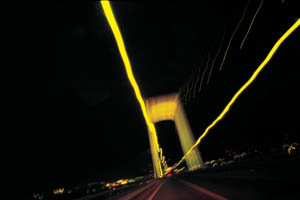A Season's Special Curse
Back to Contents of Issue: March 2004
|
|
|
|
|
|
|
This drive usually happens quite late at night, when the roads have pretty much cleared and the expressways are blessedly free of gridlock. The skyline view from the bridge is phenomenal, and is often complemented by a civilized piece of music -- Mozart's Serenade for Winds, K 361 is a favorite -- on the CD player. It is a special moment when the pressures of the day drop away. At least for most of the year.
But in early spring, these portals can turn depressing, becoming for a few nights -- or several weeks running -- my personal portes d'enfer.
Despite the congestion in this densely populated island nation, the road system is kept in surprisingly good repair. I have experienced road grids ranging from California to the Congo, and I have to admit that Japan has one of the best in terms of maintenance, organization and fluidity -- as crowded, expensive and occasionally frustrating as it is.
However, there is a singular feature of the system's existence that can assault appreciation and exhaust patience in the extreme: the nendomatsu (end of the fiscal year) road repair frenzy. This frustrating annual rite apparently serves to remind us all that we live at the mercy of the nation's road-builders who, according to author Alex Kerr (Dogs and Demons), are perhaps the largest and most entrenched part of what he terms the "construction state." As the end of March draws near, the road-builders' presence becomes an in-your-face reality of traffic tieups and detours that throws schedules into chaos and raises the blood pressure of those who must use either expressways or surface roads. (Things aren't a whole lot better for urban pedestrians, but that's another story.)
The Japanese fiscal year runs from April 1 until March 31, with its last quarter beginning with the opening of a new calendar year. In what has become an enduring tradition at all levels, the first three quarters of any given year see the allotted budgets for road maintenance and repair carefully husbanded; once the country has gone back to business as usual at the close of the New Year's holidays, there is a rush to spend the last yen.
It has become the stuff of urban legend that every few years the same spots get torn up and repaired during this season -- whether they need it or not. After a quarter-century here, I have come to suspect that there is more than a small grain of truth in this. Japanese organizational logic presumes that habitual spending will supposedly ensure a higher -- or at least equal -- budget for the following fiscal year.
The cabalistic charade is apparently accepted, because the budgets do materialize and the Japanese public just grins and bears the annual inconvenience. If Prime Minister Junichiro Koizumi is truly interested in trimming the wasteful spending habits of the entrenched interests that have hobbled the Japanese economy, terminating this childish game would be an obvious and highly appreciated place to start -- and would probably garner more votes than the lip-service schemes that habitually trickle out of the LDP. But for the moment, there's nothing to do on my part but combine Mozart with a dose of patience.
@
|
|
Note: The function "email this page" is currently not supported for this page.


 TOKYO'S RAINBOW BRIDGE SOARS high over the entrance to the inner harbor and connects the medusa-like snarl of the city's downtown expressways with the long eastward arc of the Wangan (bayshore) Expressway. After a day of meetings and errands in the capital's teeming center, the bridge's soaring towers have always marked my exit from the city and the real beginning of the long drive home to our house near the Pacific coast of Chiba Prefecture's Boso Peninsula.
TOKYO'S RAINBOW BRIDGE SOARS high over the entrance to the inner harbor and connects the medusa-like snarl of the city's downtown expressways with the long eastward arc of the Wangan (bayshore) Expressway. After a day of meetings and errands in the capital's teeming center, the bridge's soaring towers have always marked my exit from the city and the real beginning of the long drive home to our house near the Pacific coast of Chiba Prefecture's Boso Peninsula.



